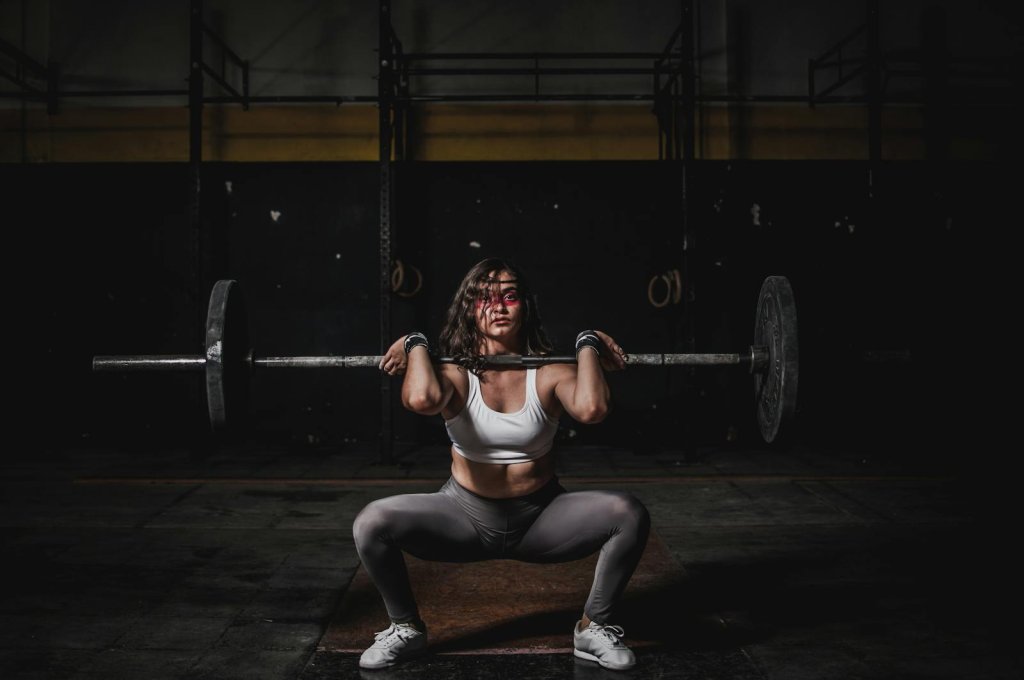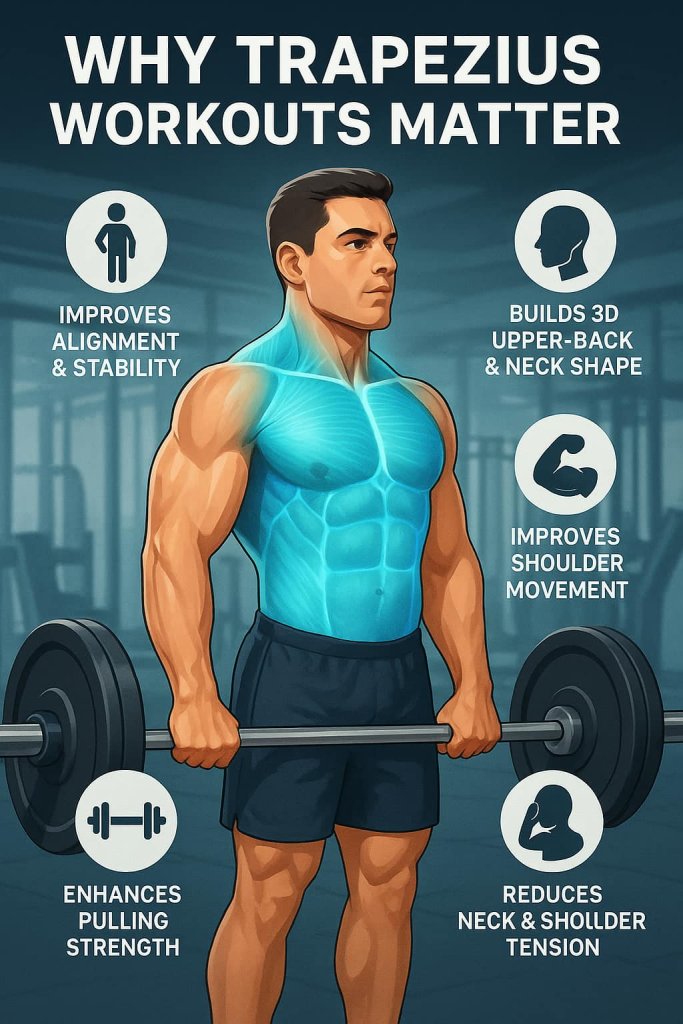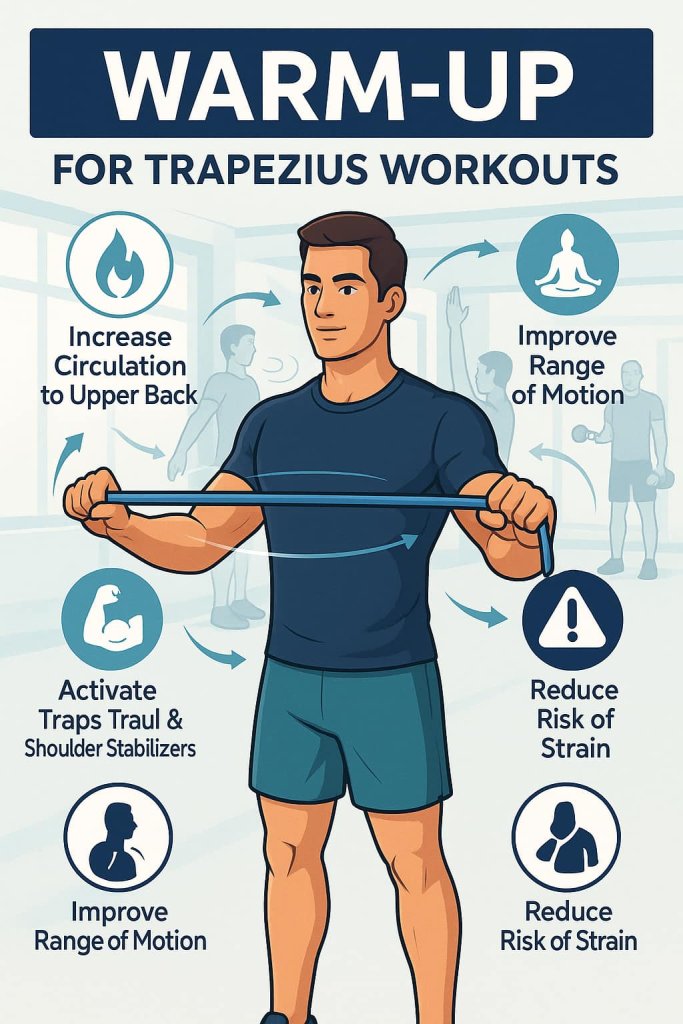The best trapezius workouts build size, strength, and posture by targeting the upper, middle, and lower traps through compound and isolation movements.
A strong trapezius not only enhances your upper-body physique but also supports shoulder stability and neck health. Whether your goal is a thicker upper back, improved posture, or stronger lifts, trap training is essential.

The trapezius plays a vital role in every pull, shrug, and press. According to Experts, well-developed traps improve overall strength and reduce shoulder injury risk. This guide breaks down the 12 most effective trapezius exercises — from classic shrugs to advanced rack pulls — to help you build a balanced, powerful upper back safely and efficiently.
Why Trapezius Workouts Matter
The trapezius muscle spans from the base of your skull down to the mid-back, influencing nearly all upper-body movements.
According to Harvard Health, trap training improves posture, prevents shoulder impingement, and supports spine alignment during everyday activities and weight training.

Key Benefits of Strong Traps:
- Build an aesthetic “3D” upper-back and neck shape
- Improve shoulder mobility and overhead stability
- Enhance pulling power in deadlifts, rows, and cleans
- Support posture and reduce neck or shoulder tension
Key Trapezius Anatomy
| Section | Location | Function | Example Exercise |
|---|---|---|---|
| Upper Traps | Between neck and shoulders | Elevates scapula | Dumbbell Shrugs |
| Middle Traps | Across mid-back | Retracts shoulder blades | Face Pulls |
| Lower Traps | Toward lower scapula | Depresses and stabilizes scapula | Prone Y-Raise |
Understanding this structure helps you target each area for balanced growth and posture improvement.
Warm-Up

Before you begin, spend 5–10 minutes activating your upper back to increase blood flow and mobility:
- Arm circles and band pull-aparts
- Scapular wall slides
- Light dumbbell shrugs
- Face pulls with resistance bands
Trainer Tip: Never skip warm-ups. They enhance neuromuscular connection, helping you “feel” your traps work during heavier lifts.
12 Best Trapezius Workouts
These 12 trapezius workouts are designed to build bigger, stronger traps while improving posture, stability, and upper-body power.
Follow them consistently to develop a thicker, more defined upper back and balanced strength.
1. Barbell Shrug
Why it works:
This foundational trap exercise directly targets the upper trapezius with heavy loads, stimulating maximum muscle fiber recruitment and growth. It builds the thick, rounded look across the upper shoulders and neck.
Muscles worked:
Upper trapezius, levator scapulae, rhomboids (stabilizers).
How to do it:
- Stand tall with feet shoulder-width apart and grip the barbell in front of your thighs.
- Keep arms straight and core tight.
- Shrug your shoulders directly upward as high as possible.
- Hold for one second at the top, then lower slowly under control.
Perform 3–4 sets of 10–12 reps.
Trainer Tip:
Avoid rolling your shoulders — this adds stress to your joints without extra benefit. Focus on moving straight up and down for better muscle contraction.
2. Dumbbell Shrug
Why it works:
Allows greater shoulder freedom and symmetrical development, engaging stabilizing muscles while increasing the trap’s range of motion.
Muscles worked:
Upper trapezius, neck stabilizers, levator scapulae.
How to do it:
- Hold a dumbbell in each hand at your sides, palms facing inward.
- Shrug both shoulders straight up toward your ears.
- Pause briefly, then lower slowly with control.
Perform 3 sets of 12–15 reps.
Trainer Tip:
Look straight ahead and keep your chin slightly tucked — this improves posture and enhances trap isolation.
3. Smith Machine Shrug
Why it works:
The fixed bar path provides safety and allows you to focus solely on overload and contraction, making it ideal for going heavier.
Muscles worked:
Upper trapezius.
How to do it:
- Stand beneath the bar with feet shoulder-width apart.
- Grip slightly wider than your shoulders.
- Shrug your shoulders upward without bending elbows.
- Hold for one second and lower under control.
Perform 4 sets of 10 reps.
Trainer Tip:
Use lifting straps for better grip during heavy sets — traps can handle more load than your hands alone.
4. Rack Pull
Why it works:
This partial deadlift variation overloads the upper and mid-traps while also strengthening the spinal erectors and grip.
Muscles worked:
Upper and middle trapezius, rhomboids, erector spinae, forearms.
How to do it:
- Set the barbell on safety pins just below knee height.
- Grip the bar slightly wider than your shoulders.
- Drive hips forward to lift the bar until standing upright.
- Lower it back under control.
Perform 3–5 sets of 6–8 reps.
Trainer Tip:
Keep your lats tight and spine neutral throughout. Don’t jerk the bar — power should come from the hips and traps.
5. Face Pull
Why it works:
A staple for improving posture and shoulder health. Strengthens the mid and lower traps while countering the effects of slouching or pressing-heavy training. (ACE, 2025)
Muscles worked:
Rear deltoids, rhomboids, middle and lower trapezius.
How to do it:
- Attach a rope handle to a high pulley at head height.
- Grip both ends and pull the rope toward your forehead.
- Spread the rope apart at the end of the pull.
Perform 3 sets of 12–15 reps.
Trainer Tip:
Keep your elbows high and focus on squeezing your shoulder blades together for maximum trap activation.
6. Upright Row
Why it works:
Targets the upper traps while also engaging the deltoids for a fuller upper-body appearance.
Muscles worked:
Upper trapezius, lateral and anterior deltoids, biceps (secondary).
How to do it:
- Hold a barbell or EZ bar with an overhand grip, shoulder-width apart.
- Pull the bar straight up to chest level, keeping it close to your body.
- Pause briefly and lower slowly.
Perform 3 sets of 10–12 reps.
Trainer Tip:
Keep your wrists and elbows aligned; lifting too high may strain the shoulders. Stop at collarbone level.
7. Farmer’s Carry
Why it works:
An excellent functional trap exercise that builds strength, endurance, and grip while improving posture.
Muscles worked:
Trapezius, forearms, deltoids, core stabilizers.
How to do it:
- Grab heavy dumbbells or kettlebells and stand tall.
- Walk 30–40 meters while keeping shoulders back and core braced.
Perform 3–4 rounds.
Trainer Tip:
Think “tall and tight” — head up, shoulders down, and abs engaged. This posture ensures optimal trap recruitment.
8. Prone Y-Raise
Why it works:
Isolates the lower traps to enhance scapular stability and correct rounded shoulders.
Muscles worked:
Lower trapezius, rear deltoids, rotator cuff stabilizers.
How to do it:
- Lie face down on an incline bench with light dumbbells.
- Raise your arms into a Y-shape above your head, keeping thumbs pointed upward.
- Hold briefly, then lower with control.
Perform 3 sets of 15 reps.
Trainer Tip:
Use very light weight — focus on quality of movement and full range of motion to prevent shoulder strain.
9. Cable Shrug
Why it works:
Constant resistance from cables ensures consistent tension on the traps throughout the movement.
Muscles worked:
Upper trapezius, neck stabilizers.
How to do it:
- Attach a straight bar to the lowest pulley.
- Hold the bar and stand tall with a slight lean forward.
- Shrug upward, hold briefly, and lower slowly.
Perform 3 sets of 12 reps.
Trainer Tip:
Keep your core tight and shoulders in line with your ears — avoid leaning back or swinging the weight.
10. Dumbbell High Pull
Why it works:
Combines power and hypertrophy by activating the traps explosively while also improving athletic coordination.
Muscles worked:
Upper trapezius, rear delts, rhomboids, biceps.
How to do it:
- Hold dumbbells with an overhand grip at thigh level.
- Pull explosively to chest height, elbows leading the movement.
- Lower with control.
Perform 3 sets of 10–12 reps.
Trainer Tip:
Keep your back straight and use controlled power. This move is about speed and precision, not jerking the weights.
11. Reverse Fly
Why it works:
Strengthens mid and lower traps, counteracting the effects of sitting and forward shoulder posture.
Muscles worked:
Middle trapezius, rhomboids, posterior deltoids.
How to do it:
- Hold dumbbells and bend forward slightly at the hips.
- With a slight bend in elbows, raise your arms out to the sides until level with shoulders.
- Lower slowly under control.
Perform 3 sets of 15 reps.
Trainer Tip:
Squeeze your shoulder blades together at the top — this enhances posture correction and scapular strength.
12. Overhead Barbell Carry
Why it works:
A powerful total-body movement that challenges trap stability, grip, and shoulder endurance.
Muscles worked:
Upper trapezius, deltoids, core stabilizers, erector spinae.
How to do it:
- Lift a barbell overhead with elbows locked and core tight.
- Walk 10–20 meters while maintaining upright posture.
- Rest and repeat.
Perform 3 rounds.
Trainer Tip:
Engage your core and keep ribs tucked to prevent arching your lower back. This builds true trap and core stability.
Pro Tips for Bigger Traps
- Progressive overload: Gradually increase weight every 1–2 weeks.
- Mind-muscle connection: Focus on squeezing your traps at the top.
- Balanced training: Include both heavy shrugs and posture-focused work.
- Avoid overtraining: Traps recover slowly — 2–3 sessions per week is optimal.
Common Mistakes to Avoid
- Rolling shoulders during shrugs — increases joint stress without benefits.
- Neglecting lower traps — leads to poor posture and shoulder imbalance.
- Using excessive weight — reduces range of motion and form quality.
- Ignoring recovery — traps are small muscles that fatigue easily.
Sample Weekly Trap Workout Plan
| Day | Focus | Key Exercises |
|---|---|---|
| Day 1 | Heavy Load | Barbell Shrug, Rack Pull, Upright Row |
| Day 2 | Posture & Activation | Face Pull, Prone Y-Raise, Reverse Fly |
| Day 3 | Functional Strength | Farmer’s Carry, Overhead Carry |
FAQ
1. How often should I train my traps?
2–3 times per week with at least 48 hours between sessions.
2. Can I train traps on shoulder or back day?
Yes. Pair upper-trap work (shrugs) with shoulders and mid/lower-trap work (face pulls, Y-raises) with back day.
3. Do shrugs alone build big traps?
Shrugs help, but you need compound lifts and posture exercises for full development.
4. What’s the best exercise for lower traps?
Prone Y-Raise and Face Pulls are top options for isolation and posture.
5. Should I train traps heavy or light?
Use a mix — heavy shrugs for mass, lighter Y-raises for endurance and stability.
6. Are trap workouts good for posture?
Yes. Strengthening mid and lower traps improves shoulder alignment and reduces slouching.
7. Can beginners train traps?
Absolutely. Start with bodyweight or light dumbbells, focus on form, and increase gradually.
Conclusion
Building strong trapezius muscles is key to a powerful, balanced upper body. Combining heavy lifts like shrugs and rack pulls with posture work like face pulls ensures complete development. Stay consistent, focus on quality movement, and your traps will grow stronger and more defined with every session.
References
- StatPearls – Trapezius Anatomy & Function (2023) – Clear clinical anatomy of upper/middle/lower traps for your anatomy section.
https://www.ncbi.nlm.nih.gov/books/NBK518994/ - Ekstrom et al., 2003 – J Orthop Sports Phys Ther – EMG shows unilateral shoulder shrugs maximally activate upper traps; great for justifying shrug variations.
https://pubmed.ncbi.nlm.nih.gov/12774999/ - García et al., 2023 – Clinical Biomechanics – Lower-trap recruitment across elevation angles; supports prone Y-raise cueing.
https://pubmed.ncbi.nlm.nih.gov/37159974/ - Pizzari et al., 2014 – Journal of Science and Medicine in Sport – Compares standard vs upward-rotation shrug; useful technique tweak for safer activation.
https://pubmed.ncbi.nlm.nih.gov/24342452/ - Arlotta et al., 2011 – Journal of Strength & Conditioning Research – Identifies exercises with selective lower-trap activation (e.g., modified prone cobra, prone row).
https://pubmed.ncbi.nlm.nih.gov/21144767/ - Castelein et al., 2016 – Manual Therapy – Shows how shoulder position (abduction/overhead) shifts trap & rhomboid EMG during shrugs/retractions.
https://pubmed.ncbi.nlm.nih.gov/26409441/ - Borms et al., 2022 – Physical Therapy in Sport – Kinetic-chain effects on upper-trap activity; informs cueing for carries/high-pull patterns and posture.
https://pmc.ncbi.nlm.nih.gov/articles/PMC9156994/ - American College of Sports Medicine (ACSM) – Resistance/Physical Activity Guidance (2024–2025) – Evidence-based baselines for frequency, sets, reps; ideal for your programming and FAQ.
https://www.acsm.org/education-resources/trending-topics-resources/physical-activity-guidelines/
